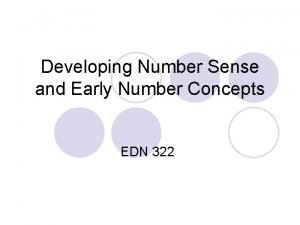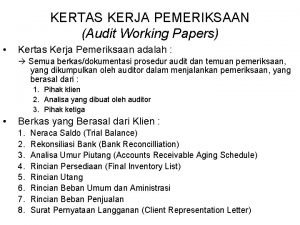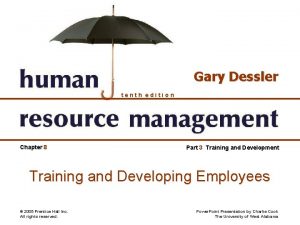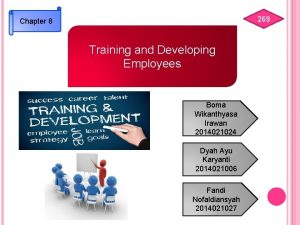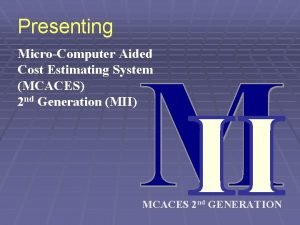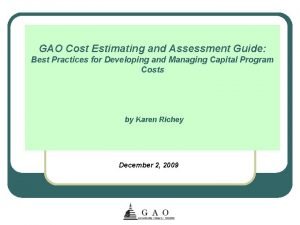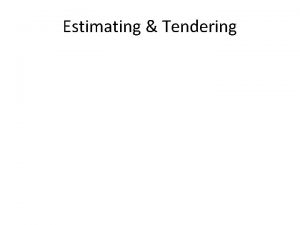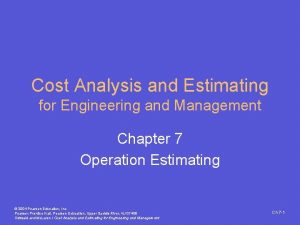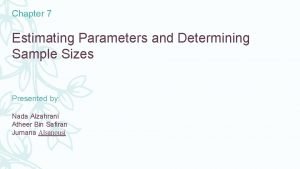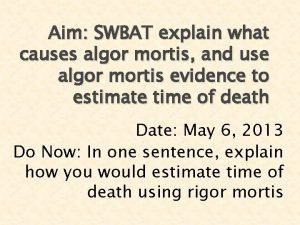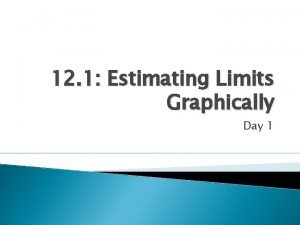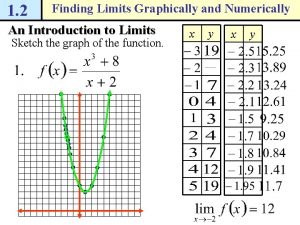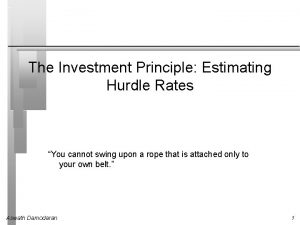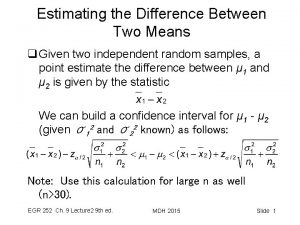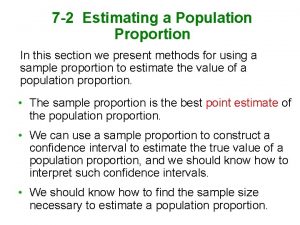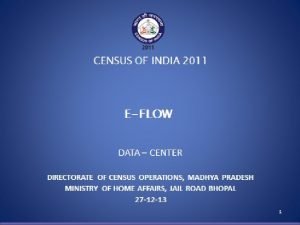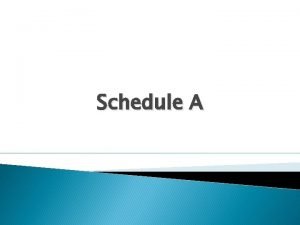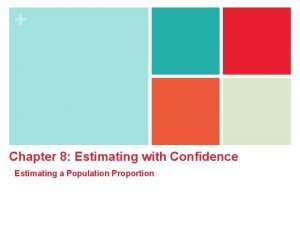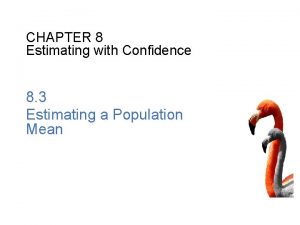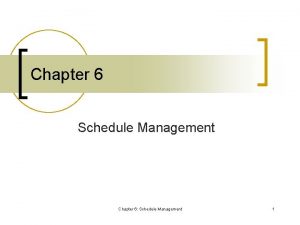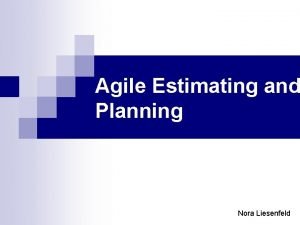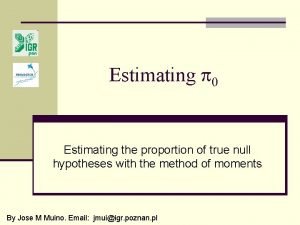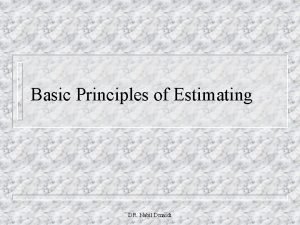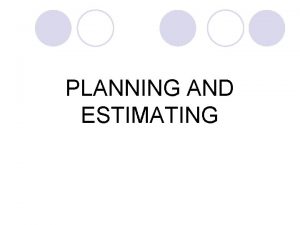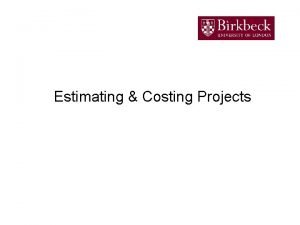5 Developing the Schedule Chapter Concepts Estimating the
















































- Slides: 48

5 Developing the Schedule

Chapter Concepts Estimating the resources required for each activity Estimating the duration for each activity Establishing the estimated start time and required completion time for the overall project Calculating the earliest times at which each activity can start and finish, based on the project estimated start time Calculating the latest times by which each activity must start and finish in order to complete the project by its required completion time Determining the amount of positive or negative slack between the time each activity can start or finish and the time it must start or finish Identifying the critical (longest) path of activities Performing the steps in the project control process Determining the effects of actual schedule performance on the project schedule Incorporating changes into the schedule Developing an updated project schedule Determining approaches to controlling the project schedule

Learning Outcomes After studying this chapter, students should be able to: Estimate the resources required for activities Estimate the duration for an activity Determine the earliest start and finish times for activities Determine the latest start and finish times for activities Explain and determine total slack Prepare a project schedule Identify and explain the critical path Discuss the project control process Develop updated schedules based on actual progress and changes Discuss and apply approaches to control the project schedule

Project Management Knowledge Areas from PMBOK® Guide Concepts in this chapter support the following Project Management Knowledge Areas of the PMI Guide to the Project Management Body of Knowledge (PMBOK® Guide): Project Integration Management Project Time Management

Cost Contingencies, Development Basis, and Project Application Background of Transit Projects Capital investment § § § Buses and facilities Rail systems Fixed guideway systems Cost contingencies § § Vary by type and level Need accurate planning, schedule development, and cost estimates Federal Transit Authority Examined 28 projects Average 7. 9% increase in costs due to schedule delays Delays caused by § § Third party reviews Unanticipated requirements Stakeholder input Project phase transitions Historical results § § Provide guidelines for delays and costs Map risks to estimate contingencies

DOE Announces the Completion of Cleanup Activities at GE Hitachi Nuclear Energy’s Vallecitos Nuclear Center Background Key Success Factors § DOE accelerated cleanup § Original plan § Clear vision of the end state § Alignment of government agency and regulators § Sufficient site characterization to have accurate information for baseline and scope planning § Funding support § Fixed-price contracting with incentives for total project performance § Management of the contract instead of the contractor § Continued focus on the goal § § 65 years $37 billion § Resulting cleanup § § § 6 project managers 54 years ahead of schedule $30 billion in cost savings

Estimate Activity Resources include § People, materials, equipment, facilities Influence on the duration § § Availability of the resources Types of resources Sufficient quantities of resources for the activity durations Potential conflicts with other projects may cause Involve person with expertise in resource estimate Estimates influence costs

Estimate Activity Durations Duration must be the total elapsed time § Time for the work to be done plus any associated waiting time

Estimate Activity Durations

Establish Project Start and Finish Times Define the overall window for project completion May not want to commit to a specific date § Project not start until customer has approved the contract § Delay in contract signing may impact project start Set finish time as number of days from project start

Develop Project Schedule Prior activities for schedule development § Estimate duration of each activity § Establish overall window of time for the project Develop the schedule timetable § Earliest start and finish times based on estimated start date § Latest start and finish times based on required completion date

Earliest Start and Finish Times Earliest start time (ES) § Earliest time at which a specific activity can begin Earliest finish time (EF) § Earliest time by which a specific activity can be completed EF = ES + Estimated Duration Calculate forward through the network diagram

Earliest Start and Finish Times Calculation Why is the ES for “Dress Rehearsal” 10? RULE 1: The earliest start time for an activity must be the same as or later than the latest of all the earliest finish times of all the activities leading directly into that particular activity

Schedule Table ES and EF

Latest Start and Finish Times Latest start time (LS) § Latest time by which a specific activity must be started Latest finish time (LF) § Latest time by which a specific activity must be completed LS = LF – Estimated Duration Calculate backward through the network diagram

Latest Start and Finish Times Calculation Why is the LF for “Print Posters & Brochures” 20? RULE 2: The latest finish time for a particular activity must be the same as or earlier than the earliest of all the latest start times of all the activities emerging directly from that particular activity

Schedule Table LS and LF

Total Slack Sometimes called float The difference between EF time of last activity and the project required completion time Negative slack § Lack of slack over the entire project § Amount of time an activity must be accelerated Positive slack § Maximum amount of time that the activities on a particular path can be delayed without jeopardizing on-time completion

Critical Path Longest path in the overall network diagram Find which activities have the least amount of slack

Critical Path Through a Project

Change in Slack for Critical Path

Free Slack Time a specific activity can be postponed without delaying the ES of its immediate successor activities Calculation § Find lowest of the values of total slack for all the activities entering into a specific activity § Subtract value from the values of total slack for the other activities also entering into that same activity

Total Slack Compared to Free Slack Total slack for Activity 7 = 50 Total slack for Activity 8 = 60 Free slack for Activity 8 = 60 – 50 = 10 days

Total slack for Activity 7 = 50 Total slack for Activity 8 = 60 Free slack for Activity 8 = 60 – 50 = 10 days

Is there any free slack here? Calculation § § Find lowest of the values of total slack for all the activities entering into a specific activity Subtract value from the values of total slack for the other activities also entering into that same activity

Bar Chart Format Gantt chart tool for planning and scheduling Activities on side Time scale on top or bottom Estimated duration in bars Automatically generated in software systems Can show relationships between activities

Project Control Process Meetings occur regularly Gather data on actual performance Record changes Monitor progress

Effects of Actual Schedule Performance Part (a) Total slack = +5 Part (b) Total slack = +2

Incorporate Changes into Schedule Changes may impact the schedule § Initiated by customer or project team § Result from unanticipated occurrence Early change may have less impact than later change Manage requested changes § Estimate impact § Obtain customer approval § Revise project plan, schedule, and costs

Update Project Schedule Generate forecasts for project finish § Use actual finish dates of completed activities § Enter project changes § Update project schedule Determine if any changes occur in critical path

Control Schedule Control Steps 1. 2. 3. 4. Analyze the schedule for needed corrective action Decide specific corrective actions to be taken Revise the plan to incorporate corrective actions Recalculate the schedule to evaluate the effects of the planned corrective actions Actions Repeat steps if not acceptable results Apply efforts to paths with negative slack § § Near-term activities Long estimated durations Change may shift critical path Trade-off of costs and scope

Scheduling for Information Systems Development Common problems § § § § § Failure to identify all user requirements Failure to identify user requirements properly Continuing growth of project scope Underestimating learning curves for new software packages Incompatible hardware Logical design flaws Poor selection of software Failure to select the best design strategy Data incompatibility issues Failure to perform all phases of the SDLC

Project Management Information Systems Most systems perform scheduling functions Calculates at click of the mouse § ES, EF, LS, and LF § Total slack § Critical path Perform control functions

Critical Success Factors The person who will be responsible for performing the activity should estimate the duration for that activity. This generates commitment from the person. The estimated duration for an activity must be based on the types and quantities of resources required to perform the activity. Activity estimated durations should be aggressive yet realistic. Activities should not be longer in estimated duration than the time intervals at which the actual progress will be reviewed and compared to planned progress. Project management involves a proactive approach to controlling a project to ensure that the project objective is accomplished even when things do not go according to plan. Once the project starts, it is important to monitor progress to ensure that everything is going according to plan. The key to effective project control is measuring actual progress and comparing it to planned progress on a timely and regular basis and taking any needed corrective action immediately. The key to effective schedule control is to address any paths with negative or deteriorating slack values aggressively as soon as they are identified. A concentrated effort to accelerate project progress must be applied to these paths.

Critical Success Factors (continued) The amount of negative slack should determine the priority for applying these concentrated efforts. When attempting to reduce the duration of a path of activities that has negative slack, focus on activities that are near term and on activities that have long estimated durations. Addressing schedule problems early will minimize the negative impact on scope and budget. If a project falls too far behind, getting it back on schedule becomes more difficult, and usually requires spending more money or reducing the scope or quality. If corrective actions are necessary, decisions must be made regarding a trade-off of scope, time, and cost. A regular reporting period should be established for comparing actual progress to planned progress. The shorter the reporting period, the better the chances of identifying problems early and taking corrective actions. During each reporting period, data on actual performance and information on changes to the project scope, schedule, and budget need to be collected in a timely manner and used to calculate an updated schedule and budget.

Summary The scheduling function depends on the planning function. The estimated types and quantities of resources required for an activity, together with the availability of those resources, will influence the estimated duration for how long it will take to perform the activity. The estimated duration for each activity must be the total elapsed time—the time for the work to be done plus any associated waiting time. The estimate should be aggressive yet realistic. It may be easier to estimate the durations for near-term activities, but as the project progresses, the project team can progressively elaborate the estimated the durations as more information becomes known to allow for more accurate estimated durations. A project schedule provides a timetable for each activity and shows the earliest start (ES) and earliest finish (EF) times and the latest start (LS) and latest finish (LF) times for each activity. The total slack for a particular path of activities through the network is common to and shared among all activities on that path.

Summary (continued) The critical path is the longest (most time-consuming) path of activities in the network diagram. The key to effective project control is measuring actual progress and comparing it to planned progress on a timely and regular basis and taking any needed corrective action immediately. Actual progress—whether faster or slower than planned—will have an effect on the schedule of the remaining, incomplete activities of the project. Any type of change—whether initiated by the customer, the contractor, the project manager, a team member, or an unanticipated event—will require a modification to the plan in terms of scope, schedule, and/or budget. Schedule control involves four steps: analyzing the schedule to determine which areas may need corrective action, deciding what specific corrective actions should be taken, revising the plan to incorporate the chosen corrective actions, and recalculating the schedule to evaluate the effects of the planned corrective actions. One of the most important factors in effective scheduling is estimating activity durations that are as realistic as possible.

Probabilistic Activity Durations

Activity Duration Estimates Used when high degree uncertainty for duration Optimistic time (to) § Time completed if everything goes perfectly well Most likely time (tm) § Time completed under normal conditions Pessimistic time (tp) § Time completed under adverse circumstances

The Beta Probability Distribution te = (to + 4(tm) + tp)/6 Example: te = (1 + 4(5) + 15)/6 = 6 weeks

Probability Fundamentals Stochastic, or probabilistic, technique § Uses the three time estimates § Allows for uncertainty Deterministic technique § Uses one time estimate Central limit theorem of probability Beta probability distribution variance § Variance = s 2 = ((tp – to)/6)2 § Standard deviation = square root of variance

Normal Probability Distribution

Example Project

Example Project: Probability Distribution

Example Project: Probable Finish Times

Calculating Probability Z = (LF – EF)/st § LF = required completion time for the project § EF = earliest expected finish time for the project (mean of the normal distribution) § st = standard deviation of the total distribution of the activities on the longest (or slowest) path leading to project completion Z = number of standard deviations between EF and LF on the normal probability curve

Example Project: Probability Distribution Use Table 5. 1 to determine percent chance to finish within the 42 days required Z = (LF – EF)/st = (42 – 36)/4. 08 = 1. 47 Probability = 0. 50000 + 0. 42922 = 0. 92922

50% 68% 95% 99% 50% 42. 922%
 Chapter 15 developing fraction concepts
Chapter 15 developing fraction concepts What is the central to developing concepts?
What is the central to developing concepts? Early number concepts
Early number concepts Early number concepts
Early number concepts Kertas kerja prosedur pemeriksaan
Kertas kerja prosedur pemeriksaan Chapter 8 estimating with confidence
Chapter 8 estimating with confidence Suppose your class is investigating the weights of snickers
Suppose your class is investigating the weights of snickers Chapter 8 estimating with confidence
Chapter 8 estimating with confidence Chapter 35 developing a business plan
Chapter 35 developing a business plan Chapter 8 training and developing employees
Chapter 8 training and developing employees Guidance skills definition
Guidance skills definition Chapter 35 developing a business plan
Chapter 35 developing a business plan Chapter 2 developing marketing strategies and plans summary
Chapter 2 developing marketing strategies and plans summary Chapter 17:3 completing job application forms
Chapter 17:3 completing job application forms Chapter 8 training and developing employees
Chapter 8 training and developing employees Chapter 3 achieving mental and emotional health answer key
Chapter 3 achieving mental and emotional health answer key Vast wilderness
Vast wilderness Chapter 11 developing and managing products
Chapter 11 developing and managing products Ilumination
Ilumination Types of information systems
Types of information systems Rounding and estimating
Rounding and estimating Mcaces
Mcaces Estimating the degradation function
Estimating the degradation function Ground rules earthwork estimating software
Ground rules earthwork estimating software Rounding decimals lesson
Rounding decimals lesson Tendering and estimating
Tendering and estimating Falguni aggarwal
Falguni aggarwal Cut and fill calculations grid method
Cut and fill calculations grid method Construction material weights
Construction material weights Estimating avogadro's number lab
Estimating avogadro's number lab Estimating and costing in electrical engineering
Estimating and costing in electrical engineering Cost analysis and estimating for engineering and management
Cost analysis and estimating for engineering and management Estimating parameters and determining sample sizes
Estimating parameters and determining sample sizes 12-1 estimating limits graphically
12-1 estimating limits graphically Agile estimating and planning by mike cohn
Agile estimating and planning by mike cohn Calculating time of death worksheet
Calculating time of death worksheet Estimating with percents
Estimating with percents 12-1 practice estimating limits graphically
12-1 practice estimating limits graphically Finding limits graphically
Finding limits graphically How to estimate whole numbers
How to estimate whole numbers First principle estimating
First principle estimating Estimate sums and differences of decimals
Estimate sums and differences of decimals Bluebeam estimating tool set
Bluebeam estimating tool set Estimating the difference between two means
Estimating the difference between two means Estimating square roots
Estimating square roots Alberto rode 5/8 of the water rides at a water park
Alberto rode 5/8 of the water rides at a water park Estimate the sum or difference 8/9 + 4/7
Estimate the sum or difference 8/9 + 4/7 Estimating a population proportion
Estimating a population proportion Unit rate estimating
Unit rate estimating


